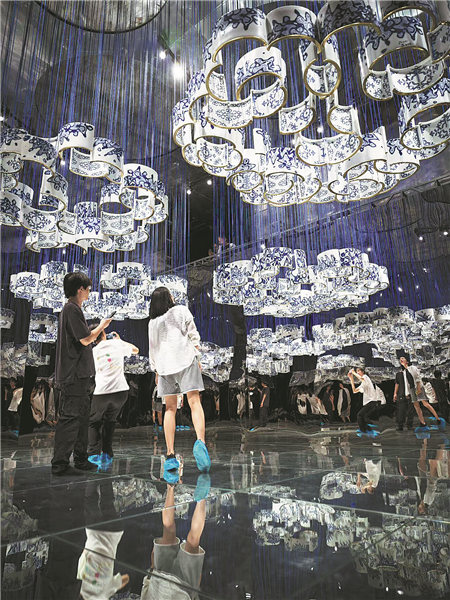Ceramic Artist Brings New Approach to Tradition

Wind, Zhu Legeng's work on display at his one-man exhibition, Creating in Inheritance, at the Chinese Traditional Culture Museum in Beijing. [Photo provided to China Daily]
Decadeslong experimentation sees master craftsman evolve techniques to give his work another dimension, Lin Qi reports.
Being raised in a celebrated ceramic-making hub like Jingdezhen, Jiangxi province, allowed Zhu Legeng to be nurtured, since childhood, by the diversity and dynamics of the city's long-standing handicraft traditions.
A synonym for the "porcelain capital" of the country, Jingdezhen is known for its sophisticated use of locally produced fine clay — molding and firing it into a variety of shapes — which has continued over the centuries.
The essence of this craftsmanship has been decorating interior and exterior environments, at home and around the world, with objects of supreme excellence, even catering to the imperial court in ancient times.
College-trained to be a ceramic artist, Zhu, a scholar of the Chinese National Academy of Arts, stands at the crossroads of the past and present. "He himself is an encyclopedia of the techniques of ancient Chinese ceramics," says Fan Di'an, the chairman of China Artists Association.
While facing the changing aesthetics brought by urbanization, Zhu has been tasked with turning his expertise in traditional techniques to serving the needs of modern society, "a common foundational issue for all Chinese artists living in a time of reforms", Fan says.
Over four decades Zhu has experimented, and is now sharing what he has accomplished at Creating in Inheritance, his one-man show, which is running at the Chinese Traditional Culture Museum until Aug 8. It explores the 71-year-old's career evolution — implanting his artistic roots deeply in classic aesthetics and being manifest in ceramic vases, paintings and sculptures on show, while forging a contemporary form of expression.
Zhu says that, since the 1990s, he has focused his work on enriching the presentation of ceramics — not just as a material for making decorative objects, but as a manifestation of clay and fire, of beautiful textures and to dominate a space. He calls his approach the art of environment ceramics.

Dancers perform in Box of Life, one of Zhu's installations, at the exhibition opening. [Photo provided to China Daily]
The ongoing exhibition displays the most recent output of this style: three installations that provide the audience with an immersive experience and extend their understanding of ceramics as an art form of infinite possibilities.
Triple Reflections of Flowers, for example, is a work on display in which dozens of qinghua cobalt blue ceramic tiles are hung in midair and reflected in mirrors that form three walls and the floor.
Zhu says the work is drawn on his study of the qinghua (patterns in cobalt blue on a white ground) porcelain, produced during the reign of Emperor Kangxi of the Qing Dynasty (1644-1911). He says that qinghua porcelain presents the chemistry between graceful outlines and patterns, and he wants to transfer that from a semitranslucent flat surface to a three-dimensional space.
The installation not only allows people to enter just to take photos. It also became a stage, where dances and traditional Chinese music were performed during the exhibition opening.
"The new concept and artistry of ceramics, which is whatever an artist dares to create, is what I'm longing to convey at the exhibition, to the audience, the art circle and also the wider ceramics industry," Zhu says.
"Opening our eyes and mind to embrace international trends, and trying to implement a cross-disciplinary approach, that is how we can keep enlivening ceramic art and pushing it forward to the forefront of contemporary art."

Heavenly Horse, by Zhu. [Photo provided to China Daily]

His installation, Triple Reflections of Flowers. [Photo provided to China Daily